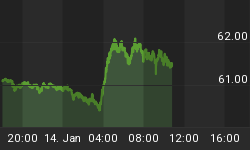Today's much weaker than expected US payrolls presents an ominous justification for further dollar selling. If the current dollar sell-off were deemed as overextended, then today's report should supports the current sell-off, paving the way for further declines on the basis of escalating chances of a June pause in rates.
It was the worst of both worlds (slower growth and rising inflationary threats) when non-farm payrolls grew by a mere 138K in April following a downward revision in March, while average hourly earnings grew 0.5%, or 3.8% y/y, the highest since August 2001. The unemployment rate remained steady at 4.7%.
We asked in our preview whether today's report was going to be sufficiently robust to provide the dollar with some sort of stability. Considering the negative dollar bias in the market, we stated that a "disappointing number (below 170-80K) would exacerbate an already deteriorating state in the greenback and raise speculation of a pause in the June FOMC meeting. The dollar reaction to a strong report (above 220-30K) should be gauged in terms of the direction as well as the duration of that increase. "
Today's report cements our expectation that the Fed will hold in June after next week's 25-bp rate hike, and we o not subscribe to the notion that the Fed continue tightening after a temporary pause. With adjustable 1-year rate at 5-year highs and weekly mortgage applications at more than 2-year lows, this highlights the risk of triggering further weakness in the housing market via accumulated backup in the bond yields.
The next shoe to drop in the dollar will be next week's US Treasury report on International Economics and Foreign Exchange. The report is a lose-lose situation for the dollar regardless of whether the US Treasury names China as a currency manipulator. The reasons are the following:
We now expect the Treasury to label China as a manipulator after the US succeeded in obtaining the backing of the 7 in singling out China in the usually generic sounding G7 FX communiqué, urging it to allow " greater flexibility in exchange rates ... critical to allow necessary appreciations".
Labeling China as a manipulator will be deemed as a protectionist measure as FX traders anticipate a follow-up trade action to the report. This would be a clear dollar negative.
In the unlikely event that the Treasury does not label China as a currency manipulator, then it would be safe to assume that a deal had been reached between Washington and Beijing in getting China to commit with a modest currency move, such as another token 1.8-2.1% revaluation in the coming months. We expect a short-lived upward knee-jerk reaction in the dollar in case China is left out, before further retreat in the currency on the rationale that the only reason the Treasury "spared" China has to be a result of a secret deal or gentlemen's agreement, as was the case in May 2005 when the Schumer-Graham 27.5% import tariff was postponed after meeting with Treasury officials and Greenspan, who must have had a tacit agreement by China to revalue, as they did later in July.
One last word on Bernanke's CNBC interpretation
The CNBC clarification of Bernanke's speech spilled much ink in financial markets, giving CNBC much valuable publicity but not such the same positive commentary to Bernanke. When asked whether the market's reaction to his Congressional testimony was warranted, Bernanke said the market got it wrong on the basis that it interpreted his speech to have announced the end of the Fed rate hikes. We think Bernanke's interpretation of the markets was inaccurate for the simple reason that the speech was the first ever speech in which Bernanke entertained a pause in the Fed's 2-year tightening campaign and in which he portrayed the housing market to be in "significant uncertainty attends the outlook for housing, and the risk exists that a slowdown more pronounced than we currently expect could prove a drag on growth this year and next". This was a departure from the "frothlike" description that was given to the housing market in the soaring days of last summer by Greenspan and even Bernanke. This was the confirmation the markets were seeking and they did get it. It is those two factors that warranted the resulting rally in bonds and stocks and sell-off in the dollar. Considering the sell-off in the dollar, it did make sense for Bernnake to describe the market reaction as a misinterpretation when he was given the opportunity to do so.
Our FX Forecasts:
EURUSD at 1.2750 by month end, 1.28 by end of July; 1.25 by end of Oct, 1.30 by year-end.
USDJPY at 111 by month end, 109 by end of July; 107 by end of Oct, 1.03 by year-end.
GBPUSD at 1.8470 by month end, 1.85 by end of July; 1.82 end of Oct, 1.88 by year-end.
USDCHF at 1.2250 by month end, 1.22 by end of July; 1.2350 end of Oct, 1.18 by year-end.















